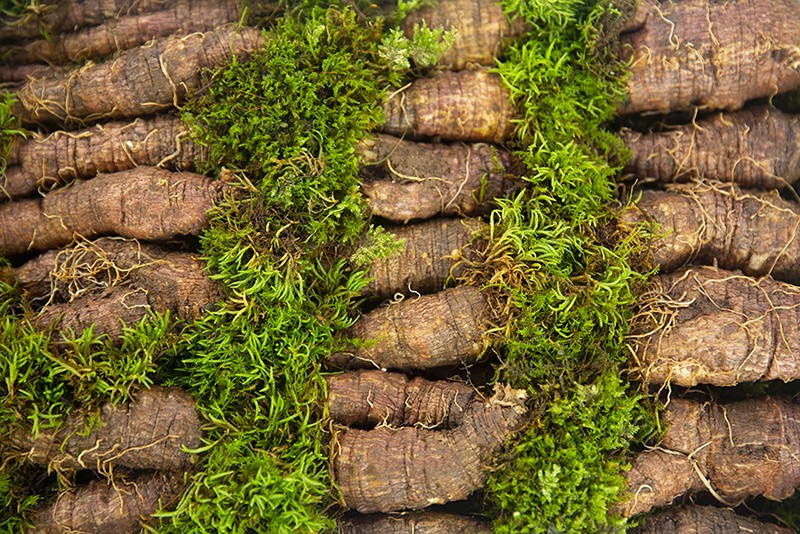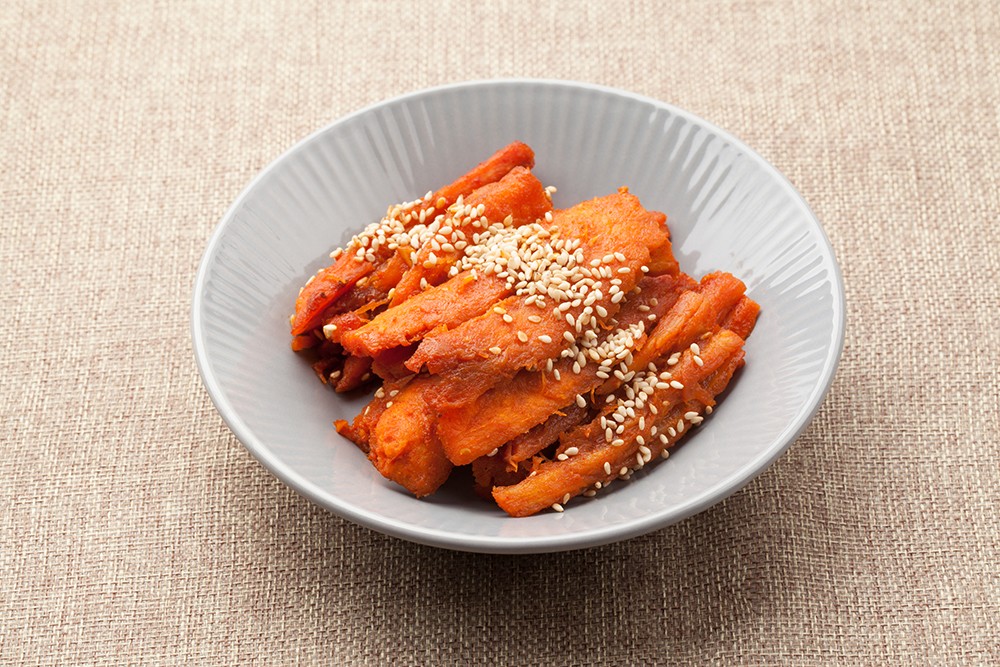한식 읽기 좋은 날
Vol 61. Mountains and Nature
Deodeok, a Gem with a Unique Bitter Flavor and Aroma
Captivated by HANSIK
Known for its bitter taste and unique aroma, deodeok has been recognized as a “health food” while being used as an herbal medicine ingredient since the ancient times. It has been attracting attention lately as it is rich in minerals, saponin, and dietary fiber. This article will delve into what kind of root vegetable deodeok is, and how to enjoy it deliciously.
Article Noh Yunyeong Sources <Deodeok, a Meat Grown in the Mountains> (Nongsaro), <Agricultural Technology Guide – Cultivating Wild Greens> (The Rural Development Administration>

Healthy food with a bitter flavor
Deodeok (herb medicine name: Yangyu), a perennial vine plant of the bonnet bellflower family, grows in forests. There are about 40 species distributed not only in Korea, but also in East Asia, such as Japan, China, and India. In Korea, it is produced in Yeoju, Icheon and Gimpo in Gyeonggi-do, Hongcheon, Samcheok and Hoengseong in Gangwon-do, and Geumsan and Nonsan in Chungnam. Initially, people relied on wild harvesting, but as its reputation as a health food increased, demand increased rapidly, and the cultivation area also increased accordingly. It is easy to think that it should be grown in a shaded area without sunlight, but it should be grown in a sunny area for a high yield, and to ensure steady growth and development. This is because deodeok belongs to plants that like sunlight. Deodeok increases the saponin and fragrance components as the temperature difference increases. Deodeok, which usually grows in the mountains, has extremely low light intensity and plenty of organic matter in the soil compared to cultivated fields. Wild deodeok grown in such a complex environment has a stronger aroma and higher saponin content, but the yield is small. On the other hand, deodeok grown by people in a field-like cultivation area can be harvested in large quantities, but has a weak aroma.
It is known as a health food because it is rich in minerals such as calcium and iron, and dietary fiber, which is good for preventing constipation, and saponin, a medicinal component. Raw deodeok is used for grilling, seasoning, salad, water kimchi, frying, pickling, etc., and dried deodeok is made into powder and drunk as tea or used as food ingredients for red chili paste, etc. The thick, bloated root is mainly consumed, and it is sometimes misunderstood since it is like ginseng because of its unique aroma and bitter flavor.
The bitter flavor of deodeok is due to its saponin component. Saponin, which is also contained in ginseng, moisturizes the lungs and bronchi by improving bronchial mucus secretion. It also removes phlegm, lowers fever, and releases toxin. It is effective in preventing vascular disease and cancer, as well as treating coughs accompanied by chest pain, phlegm, asthma, high blood pressure, and inflammation.
Since the ancient times in China, it was used as a medicinal product, and in Korea, the root of deodeok is called “sasam” because it has medicinal effects comparable to wild ginseng. The etymology of deodeok is not known exactly, but according to the <Xuanhe Fengshi Gaoli Tujing> written by Jing Xu, who came to Goryeo as an envoy from the Song Dynasty in 1123, “There is deodeok among the vegetables served daily in the government, and its shape is large and the flesh is soft and tasty. It does not seem it is used as a medicine.” It can be assumed that it was already called “deodeok,” and was consumed at this time. Moreover, <Jeungbo Sallim Gyeongje (Revised Farm Management)>, a book on agriculture written in 1766, mentions that it is transplanted in February, so it seems that it was cultivated directly as well as harvested wild.

Various ways to enjoy deodeok
When choosing a deodeok, it is good to have one that is white and has thick roots, and its body is straight. Before consuming deodeok, it must be trimmed. Wash off the dirt and peel off the outer skin. This time, be careful not to soak them in water for a long time. This is because saponin is well soluble in water. If you peel it, soak it in salt water for a short while, and take it out. The bitter flavor is reduced, while the saponin component is preserved.
There are many ways to eat deodeok. The young leaves are boiled and mixed with vegetables or eaten as wraps, and the roots are used to make gochujang jangajji (pickled deodeok in red chili paste), saengchae (fresh salad), jabang (salted deodeok), gui (grilled deodeok), nureumjeok (pan-friend deodeok), jeonggwak (braised deodeok in sweet sauce), and sul (liquor). Among them, deodeokgui, which is made with newly harvested deodeok, sliced and grilled, is loved by many people. After pounding the thinly sliced deodeok with the back of a knife, soak it in cold water, and squeeze it. Then, when it is mixed with sesame oil, and grill on the grill while evenly applying the sauce. The deodeokgui that we know well will be completed. Other dishes include deodeok nuts, taffy jangjorim (braised deodeok in soy sauce with nuts and taffy) made with nuts, and rice syrup that children can easily eat. Chapssal deodeok twigim (fried deodeok in sweet rice) made with sweet rice powder and frying powder can be enjoyed by the whole family.

 한국어
한국어
 English
English






